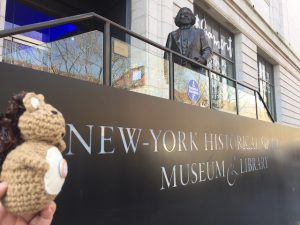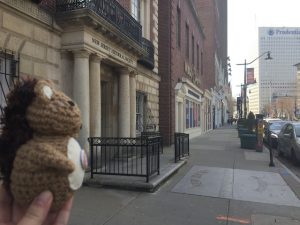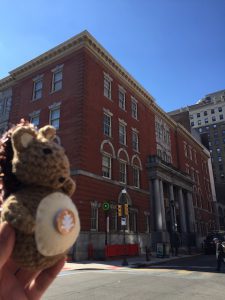Many researchers find the Mid-Atlantic region intimidating. However, with so many of our ancestors passing through at some point, it really is worth going through the effort to find resources. The Mid-Atlantic region has such fascinating history as peoples of different backgrounds, especially religious, made homes there. It can be highly enjoyable digging out their stories in the historical societies of New York, New Jersey, and Pennsylvania.
Continuing our series, begun in southern and northern New England, we round out the Northeast. Below are some tips to make the Mid-Atlantic easier to navigate.
New York Historical Society
https://www.nyhistory.org/library170 Central Park West, New York, N.Y.
Open Tues.–Fri., 10 a.m.–4:45 p.m.
Free to use library; $21 to visit exhibits.
Prep Tips:
- Search the online catalog and check the finding aids. Items can only be requested through the collections request system, so it is best to order in advance of a visit.
- Staff recommends searching by subject. Each item's catalog record will have a list of linked Subject Headings that will allow you to explore the collections under similar subjects. Limit the search by record type, either through the advance search or through the sidebar. Look for call numbers that include AHMC (American Historical Manuscript Collections) and BV (bound volume).
- Email reference@nyhistory.org for tips about visiting and searching the catalog and finding aids. (A staff member responded to me within just a few hours.)
- Make an appointment in advance (via printroom@nyhistory.org) to view items from the Department of Prints, Photographs, and Architectural Collections. No appointment is necessary for the Manuscript Collections or Printed Collections.
Registration Process:
- Register electronically through Aeon, the collection request system. This is only necessary the first time, but they can merge the accounts in cases of creating duplicates.
- Upon arrival, go to the coat check next to admissions. They provide clear plastic bags for allowed items (wallet, phone, chargers, etc.) and a tag to retrieve any checked items (all bags, outerwear, folders, etc.).
- At the top of the first set of stairs, enter the Patricia D. Klingenstein Library, and check in at the desk just inside the door. A government issued I.D. (driver’s license, passport, etc.) is required.
Requesting Items:
- Request up to 10 items at a time through the online catalog. See instructions for the catalog and the finding aids.
- As there are multiple desks and staff members who may be able to retrieve items, ask the attendant at the door who to approach. Usually, one desk is designated for manuscripts, but during one visit, multiple people at two different desks handled manuscripts (while the official person worked on a project).
- Let the correct staff member know which items (requested online) to bring out first because they only retrieve about four items at a time.
- Take a seat as indicated. A staff member will load a cart with your requests and place the first on the table. Let the staff know when you are ready for the next item.
FYI:
- Try to have all notes in electronic form. Only five sheets of loose papers are allowed, writing paper is available in the reading room.
- Photos allowed.
- Wi-Fi available.
- The museum has changing exhibits and films worth exploring. They are located across the street from Central Park and a block from the American Museum of Natural History (with a convenient subway station).
New Jersey Historical Society
https://jerseyhistory.org/52 Park Place, Newark, N.J.
Tues.–Sat., 12–5 p.m. (by appointment)
Free to members; $5 non-members.
Prep Tips:
- NJHS has four different ways of identifying materials that may be of interest:
- Guide to Our Card Catalogs: provides a good overview of their collections and may be a good starting point.
- Archives Finding Guides: leads to the finding aids with more descriptions and content lists by box and folder.
- Genealogist’s Guide: functions more like a bibliography.
- Library Finding Guides: functions more like a bibliography.
- Email library@jerseyhistory.org to make an appointment to visit. Include: name, address, phone number, email, and the date and time you would like to visit. (A staff member responded to me the same day I emailed.)
Registration Process:
- If desired, complete the registration form in advance. Bring a photo I.D. to complete registration upon arrival.
- Sign in and out of the building at the desk near the entrance.
- Place all bags, outerwear, etc. in the lockers across from the desk and keep the key.
- A staff member will escort visitors on the elevator to the reading room and introduce them to the archivist on duty.
Requesting Items:
- Include a list of items when emailing for an appointment and they will pull them in advance. Provide the name of the item or collection with the call number (and box and folder numbers if applicable).
- Take a seat and the archivist will bring all requested items to the table.
FYI:
- The photo policy is very limiting, though digital cameras are allowed. Sign and bring the camera use policy.
Historical Society of Pennsylvania
https://hsp.org/1300 Locust Street, Philadelphia, Pa.
Tues. & Thurs., 12:30–5:30 p.m.; Wed., 10 a.m.–8:30 p.m.; Fri., 10 a.m.–5:30 p.m.
Free to Friends of HSP, students, and military; $8 general admission.
Prep Tips:
- Search the online catalog Discover. The Library 101 Guide suggests searching by a surname followed by the word “family” to find genealogies and family history records. You can be creative and experiment with key words. All of their collections have at least a brief description in the online catalog Discover.
- Their website provides a directory of staff emails, but it was not clear whom to contact for queries in preparation of a visit. Having tried the Head of Reference Services, the response (that same day) came from the Director of Research Services. Thus, it may be worth calling (215-732-6200) to reach the person best able to provide assistance.
- Finding aids are available either through the catalog or in paper form at the reference desk, located outside the reading room. Try checking there before settling in Restricted Use Area since they do not like items left unattended. However, the reference desk was not consistently staffed during this visit.
Registration Process:
- Complete a Research Registration Form. This can also be completed at the front desk, where the greeter provides an overview of their policies and a researcher badge that must be worn.
- Place all bags, outerwear, etc., in the lockers in the entry way. Some are quite large and easily fit everything. Each has a key.
- The greeter buzzes visitors in and out of the secure area through the gates on each side of the front desk. The room on the other side of the gates features some exhibit materials and the reference desk.
Requesting Items:
- The room beyond the reference desk has the Restricted Use Area and the desk for submitting manuscript requests.
- Complete three call slips at a time. Include the seat number, which can be found on the edge of the tables in the Restricted Use Area. The next set of call slips can be submitted upon retrieving the third item.
- Staff will bring the first item to the seat. After that, bring each item to the desk to retrieve the next. They allow one box at a time.
FYI:
- Photos are allowed but not video or scanners. They provide a white slip of paper with a copyright notice that needs to be placed within each photograph frame.
- Wi-Fi available.
Share this:
About Kyle Hurst
Kyle, Genealogist of the Newbury Street Press, holds a B.A. in both history and anthropology from the University of Wisconsin in Madison and has a master’s certificate in Museum Studies from Tufts University. With experience at the National Archives and Record Administration in Waltham, Kyle has worked on a wide variety of research projects as part of the Research Services team at NEHGS and, with Newbury Street Press, has contributed to a number of family histories. She has been credited for her contributions to The Root, TheRoot.com, and she has also written for American Ancestors magazine.View all posts by Kyle Hurst →


